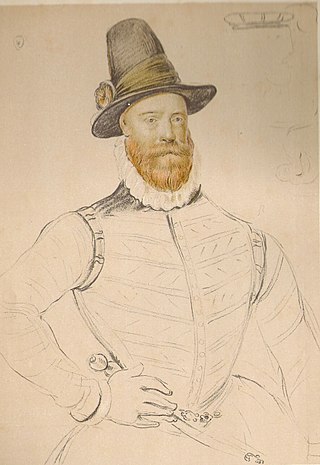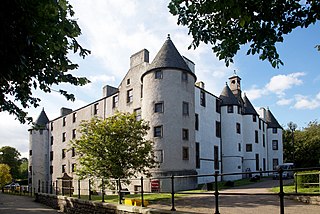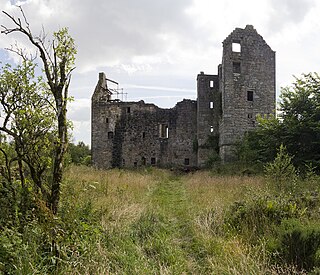
Alexander Erskine of Gogar (died 1592) was a Scottish landowner and keeper of James VI of Scotland at Stirling Castle.

Alexander Erskine of Gogar (died 1592) was a Scottish landowner and keeper of James VI of Scotland at Stirling Castle.
Alexander was a son of John Erskine, 5th Lord Erskine and Lady Margaret Campbell, a daughter of Archibald Campbell, 2nd Earl of Argyll. As the younger son, he was called the "Master of Mar." He was also laird of the lands of Gogar, Logie, a place near Stirling. After the death of his brother, John Erskine, Earl of Mar, Alexander was given the task of safeguarding the young king of Scotland at Stirling in 1572. [1]
With a role of such importance as the representative of the House of Mar while the Earl was still a minor, Alexander was offered a pension from England of £150 a year, for which he was recommended by Regent Morton in 1574 as "well friended, constant, of good credit and power." In 1575, Francis Walsingham heard that Morton secretly planned to take the King out of Alexander's keeping. This was not in Morton's power, as the appointment had been made by the Parliament of Scotland. Walsingham resolved to make Alexander an ally of England, in case Morton lost his position. The crisis of 1575 blew over. [2]
After James Douglas, Earl of Morton resigned the Regency of Scotland, on 28 March 1578, Alexander was appointed Keeper of Edinburgh Castle in the place of George Douglas of Parkhead. [3] Alexander undertook to look after the artillery of the castle and the coffer of jewellery which had belonged to Mary, Queen of Scots. [4] In January 1579, the keys of the coffer were given to William Ruthven, 1st Earl of Gowrie, as treasurer of Scotland. [5]

Alexander Erskine of Gogar was ousted from his duty at Stirling by his kinsman and ally of the former Regent Morton, Adam Erskine Commendator of Cambuskenneth, in April 1578. [6] The events were described by the English diplomat in Scotland, Robert Bowes. Adam Erskine had persuaded Alexander's nephew, the young Earl of Mar that he should be the guardian of James VI. Adam Erskine and his brother David Erskine, Commendator of Dryburgh, and the Earl of Mar, who were all lodged in Stirling Castle, came to the gate early on Sunday morning, 27 April 1578, pretending to go out to join a hunt. The two Commendators met Alexander, who held the castle keys, and began to argue with him over the guardianship of the King.
Alexander seized a halberd and called his servants. There was a brief struggle, and then Alexander and the Commendators went into the Great Hall to discuss the matter. Colin Campbell, 6th Earl of Argyll was also present in the castle with his followers, and was prepared to fight, but eventually they decided to yield to the young Earl of Mar. During the struggle at the Castle, Gogar's eldest son was fatally injured and a servant called Buchanan was hurt. The young king was said to have torn his hair in distress during the incident, fearing that Alexander was killed.
Alexander and Argyll then left Stirling, both parties and the King's tutor George Buchanan having written letters to the Privy Council in Edinburgh to declare that all were reconciled and that nothing had changed that would affect the government of Scotland. [7]
Despite these letters, the effect of the change of hands at the Castle was to help the former Regent Morton regain some of his power, because previously he had lost access to the King's authority. Elizabeth I of England, who was a supporter of Morton's rule, sent a letter of support to the Earl of Mar. [8] Morton would later deny any involvement in the events at Stirling Castle. [9]
A 17th century historian of the Douglas family David Hume of Godscroft noted the lack of evidence for Morton's involvement, and suggested that Erskine of Gogar was "a man of a good easie nature, and no ill disposition, ... nothing factious or malicious" but had been an instrument of others, firstly in giving access to the King to Morton's opponents at Stirling, and then "almost after the same manner" being turned out of the Castle himself. Hume of Godscroft suggested, with no evidence but hearsay, that the Comptroller of the Exchequer William Murray of Tullibardine, the Earl of Mar's uncle, might have been behind the removal of Gogar from Stirling Castle and employed by Morton. [10]
On 23 December 1583 Ludovic Stewart, 2nd Duke of Lennox was made the High and Great Chamberlain of Scotland, and first Gentleman of the King's Bedchamber, as his father had been, and Alexander Erskine of Gogar, Captain of Edinburgh Castle was made his depute. The role included taking oaths of fidelity to the King from the other officers, ushers, and varlets of the Bedchamber and Wardrobe. [11]
In December 1584 Erskine received a royal gift of income from the customs of Edinburgh and other lands, for his work as Captain of Edinburgh Castle, and for keeping the King's House in Striling during the king's minority years. [12]
He died in 1592.
Alexander married Margaret Home in 1564, a daughter of George Home, 4th Lord Home and Mariotta Haliburton. Their children included:
| Alexander Erskine's relatives (selective chart) | ||||||||||||||||||||||||||||||||||||||||||||||||||||||||||||||||||||||||||||||||||||||||||||||||||||||||||||||||||||||||||||||||||||||||||||||||||||||||||||||||||||||||||||||||||||||||||||||||||||||||||||||||||||||||||||||||||||||||||||||||||||||||||||||||||||||||||||||||||||||||||||||||||||||||||||||||||||||||||||||||||||||||||||||||||||||||||||||||||||||||||||||||||||||||||||||||||||||||||||||||||||||||||||||||||||||||||||||||||||||||||||||||||||||||||||||||||||||||||||||||||||||||||||||||
|---|---|---|---|---|---|---|---|---|---|---|---|---|---|---|---|---|---|---|---|---|---|---|---|---|---|---|---|---|---|---|---|---|---|---|---|---|---|---|---|---|---|---|---|---|---|---|---|---|---|---|---|---|---|---|---|---|---|---|---|---|---|---|---|---|---|---|---|---|---|---|---|---|---|---|---|---|---|---|---|---|---|---|---|---|---|---|---|---|---|---|---|---|---|---|---|---|---|---|---|---|---|---|---|---|---|---|---|---|---|---|---|---|---|---|---|---|---|---|---|---|---|---|---|---|---|---|---|---|---|---|---|---|---|---|---|---|---|---|---|---|---|---|---|---|---|---|---|---|---|---|---|---|---|---|---|---|---|---|---|---|---|---|---|---|---|---|---|---|---|---|---|---|---|---|---|---|---|---|---|---|---|---|---|---|---|---|---|---|---|---|---|---|---|---|---|---|---|---|---|---|---|---|---|---|---|---|---|---|---|---|---|---|---|---|---|---|---|---|---|---|---|---|---|---|---|---|---|---|---|---|---|---|---|---|---|---|---|---|---|---|---|---|---|---|---|---|---|---|---|---|---|---|---|---|---|---|---|---|---|---|---|---|---|---|---|---|---|---|---|---|---|---|---|---|---|---|---|---|---|---|---|---|---|---|---|---|---|---|---|---|---|---|---|---|---|---|---|---|---|---|---|---|---|---|---|---|---|---|---|---|---|---|---|---|---|---|---|---|---|---|---|---|---|---|---|---|---|---|---|---|---|---|---|---|---|---|---|---|---|---|---|---|---|---|---|---|---|---|---|---|---|---|---|---|---|---|---|---|---|---|---|---|---|---|---|---|---|---|---|---|---|---|---|---|---|---|---|---|---|---|---|---|---|---|---|---|---|---|---|---|---|---|---|---|---|---|---|---|---|---|---|---|---|---|---|---|---|---|---|---|---|---|---|---|---|---|---|---|---|---|---|---|---|---|---|---|---|---|---|---|---|---|---|---|---|---|---|---|---|---|---|---|---|---|---|---|---|---|---|---|---|---|---|---|---|---|---|---|---|---|---|---|---|---|---|---|---|---|---|---|---|---|---|---|---|---|---|---|---|---|---|---|---|---|---|---|---|---|---|---|---|---|---|---|---|---|
| ||||||||||||||||||||||||||||||||||||||||||||||||||||||||||||||||||||||||||||||||||||||||||||||||||||||||||||||||||||||||||||||||||||||||||||||||||||||||||||||||||||||||||||||||||||||||||||||||||||||||||||||||||||||||||||||||||||||||||||||||||||||||||||||||||||||||||||||||||||||||||||||||||||||||||||||||||||||||||||||||||||||||||||||||||||||||||||||||||||||||||||||||||||||||||||||||||||||||||||||||||||||||||||||||||||||||||||||||||||||||||||||||||||||||||||||||||||||||||||||||||||||||||||||||

James Douglas, 4th Earl of Morton was a Scottish nobleman. He played a leading role in the murders of Queen Mary's confidant, David Rizzio, and king Henry Darnley. He was one of the last of the four regents of Scotland during the minority of James VI and I. He was in some ways the most successful of the four, since he won the civil war that had been dragging on with the supporters of the exiled Mary, Queen of Scots. However, he came to an unfortunate end, executed by means of the Maiden, a predecessor of the guillotine.
John Stewart, 4th Earl of Atholl, called the Fair, was a Scottish nobleman and courtier. He was favoured by Mary, Queen of Scots, but later turned against her.
Archibald Douglas, 8th Earl of Angus and 5th Earl of Morton was a Scottish aristocrat.
William Douglas, 6th Earl of Morton was the son of Robert Douglas of Lochleven and Margaret Erskine, a former mistress of James V of Scotland.

John Erskine, 1st Earl of Mar was a Scottish aristocrat and politician. He was the custodian of the infant James VI of Scotland and Regent of Scotland.

John Erskine, 2nd Earl of Mar was a Scottish politician, the only son of another John Erskine and Annabella Murray. He is regarded as both the 19th earl and the 2nd earl.
John Erskine, 5th Lord Erskine was a Scottish nobleman.

Thomas Erskine, 1st Earl of Kellie was a Scottish peer.
Mariotta or Maryon or Marion Haliburton, Lady Home was a 16th-century Scottish noblewoman. She varied the spelling of her forename between Mariotta, Marion, and Mary. She is remembered for her defence and negotiation of the surrender of Hume Castle after the Battle of Pinkie when the castle was surrounded by an English army. Afterwards she continued to struggle for the rights of her people at the village of Hume in the Scottish Borders, writing both to the English commander and the Scottish leader.

Mar's Wark is a ruined building in Stirling built 1570–1572 by John Erskine, Regent of Scotland and Earl of Mar, and now in the care of Historic Scotland. Mar intended the building for the principal residence of the Erskine family in Stirling, whose chief had become hereditary keeper of the nearby royal Stirling Castle where the princes of Scotland were schooled. Wark is a Scots language word for work, and here it means building. The house is also called "Mar's Lodging."

The Cunninghams of Drumquhassle were a family of the landed gentry in Scotland from the early 16th century to the mid-17th. They are linked to the Cunninghams of Kilmaurs in Ayrshire, being descended through junior lines via the Cunninghams of Polmaise. At their greatest extent, their lands included Mugdock-Mitchell and the house at Killermont, covering the part of parishes of Strathblane and New Kilpatrick. John Cunningham, the third laird held several positions of responsibility within the Scottish court, including Master of the Royal Household for James VI and a Collector General of tax during the regency of the Earl of Lennox, but his involvement in the power struggles between the Scottish nobility and the court of Elizabeth I of England also led to his demise and he was executed for treason in 1585. Over the next century, the family lost its land and power – in the mid-17th century, the Cunninghams sold their country house in Drumquhassle in rural Stirlingshire and it passed to the Govane family.
Laurence Oliphant, 4th Lord Oliphant (1529–1593) was a Scottish nobleman.
Sir George Home of Wedderburn was briefly Comptroller of the Scottish Exchequer in the household to James VI of Scotland.
Annabell Murray, Countess of Mar (1536–1603), was a Scottish landowner, courtier and royal servant, the keeper of the infant James VI and his son Prince Henry at Stirling Castle
Michael Gardiner was a Scottish artilleryman based at Stirling Castle. The surname also appears as Gardner and Gardenar.

James Scrimgeour Scottish landowner and Constable of Dundee.

Alexander Forrester of Garden was a Scottish landowner. He was the son of David Forrester of Torwood and Garden and Elizabeth Sandilands, daughter of James Sandilands of Slamannan.
Adam Erskine, Commendator of Cambuskenneth, was a Scottish landowner and courtier.
David Erskine, Commandator of Dryburgh was a Scottish landowner.
George Auchinleck of Balmanno was a Scottish courtier and servant of Regent Morton in the 1570s.